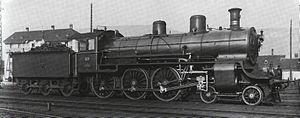SBB A 3/5 601-649
| SBB A 3/5 NS series 3500 |
|
|---|---|
| Numbering: | 601-649 |
| Manufacturer: | Winterthur |
| Year of construction (s): | 1907-1915 |
| Gauge : | 1435 mm ( standard gauge ) |
| Length over buffers: | 18,740 mm |
| Fixed wheelbase: | 4350 mm (4150 mm) |
| Total wheelbase: | 860 mm (8450 mm) |
| Wheelbase with tender: | 15,400 mm |
| Service mass: | 71.1 t (65.8 t) |
| Service mass with tender: | 114.8 t (109.5 t) |
| Friction mass: | 48.0 t (45.7 t) |
| Top speed: | 100 km / h |
| Driving wheel diameter: | 1,780 mm |
| HD cylinder diameter: | 425 mm |
| LP cylinder diameter: | 630 mm |
| Piston stroke: | 660 mm |
| Boiler overpressure: | 14 bar |
| Number of heating pipes: | 152 |
| Number of smoke tubes: | 21st |
| Heating pipe length: | 4500 mm |
| Grate area: | 2.80 m² |
| Radiant heating surface: | 15.5 m² |
| Superheater area : | 42.4 m² |
| Evaporation heating surface: | 203 m² |
| Water supply: | 18.0 m³ |
| Fuel supply: | 7.0 tons of coal |
| Drive: | Superheated steam quadruple compound machine |
SBB A 3/5 601-649: The Swiss Federal Railways procured from 1907 to 1915 a total of 49 hot steam, four-cylinder composite express train - steam engines , which were classified under the series name A 3/5.
General
The chassis is based on the JS A 3/5 and, in contrast to this, has a superheated steam four-cylinder drive instead of a wet steam. Some improvements that had already been made with the GB A 3/5 were also adopted, as it was supposed to support this series of locomotives.
In 1907 the SLM had four locomotives built whose chassis dimensions corresponded to the JS A 3/5 so that a comparison could also be made. Two each were equipped with a superheated steam drilling machine ( SBB A 3/5 h3 ) and two with a superheated steam four-cylinder machine. The latter was then reordered as a series and delivered between 1910 and 1915.
Technical
The series machines have a fixed center distance extended by 200 mm, and the weight is also higher than that of the two pre-series machines.
Without a superheater, they had a heating surface of 161.60 m².
They were 3-axle Tender equipped.
The locomotive developed 1,500 hp and was able to move a 350-ton train on a 10 ‰ slope at 50 km / h.
Operational
The locomotives were built for mixed service.
Up until the electrification of the Gotthard route, they were, together with the superheated steam GB A 3/5, the standard locomotives for the express trains over the Gotthard immediately after delivery , but were usually given a leader locomotive on the ramps while they covered the route from Zurich / Lucerne to Bellinzona went through. Due to the rapidly advancing electrification of the main lines, they quickly lost their traditional area of application. They were assigned to the Yverdon , Biel and Zurich depots in districts I-IV .
In the mid-1930s, the first 600 series (1934 the number 620 from 1912) were retired. By 1946, the 613 and a further 21 of these locomotives were taken over by the Dutch Railways (NS) after they were retired and recorded there as the 3500 series. In 1952 they were also retired from the NS. From the 600 series, including the locomotives sold in the Netherlands , no examples have survived. In terms of operating kilometers and years of operation, they were nevertheless the most successful Swiss express locomotives. No. 616 was an exhibit at the international exhibition in Turin, No. 634 was presented at the Swiss National Exhibition in Bern.
literature
- Alfred Moser : The steam operation of the Swiss railways 1847-1966. 4th updated edition. Birkhäuser, Stuttgart 1967, p. 261ff.
- Heinz Rihs: Steam locomotives A3 / 5. In: Loki Special. 33. Lokpress, Zurich 2011.
